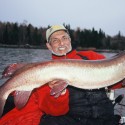By Spence Petros
I love catching crappies, especially big ones. While many anglers head to the shallows right after ice out, targeting sheltered bays, canals, and other early to warm spots, most over-look adjacent deeper weedy bays. This pattern was shone to me by good friend Billy Heim, one of the top guides prowling southern Wisconsin waters. Even if the shallows are producing, often the 12 to 15-inch slabs are holding in these deeper adjacent waters.
Despite these bays having plenty of weeds during warmer weather, healthy vegetation is virtually non- existent shortly after ice-out. What you search for is slight changes on the bays slow tapering flats. Key spots to target might be a slight hump, slot, or even a higher clump of dead weeds. If you find something a little different from the surrounding bottom, you have two choices; GPS it (and several others) and come back and fish them later, or back off and fish it now. Allow at least 10-15-minutes for things to settle down and for the crappies to become active.
When fishing a spot it’s best to double anchor and fish very slowly since the water temperature is generally in the high 30’s to mid 40-degree range. On clearer lakes the best action is usually early or later in the day, unless you get good cloud cover. Our best day last year was during scattered snow showers. . Don’t be afraid to get out at day break, especially if the nighttime lows weren’t below the existing water temperatures.
To catch the most fish you are just about using ice-fishing tactics. Spinning rods in the 9 to 10-foot range are preferred because you will catch more fish using fixed floats as opposed to slip floats. And since you are often fishing 6 to 8-feet down, you need to use a longer rod. Baits generally are small minnows and/or wax worms on a small jig head. A split shot is attached about 18-inches above the jig to give you a little extra weight for casting. Super-sensitive thin quill-type floats complete your presentation package for these big early spring crappies.

